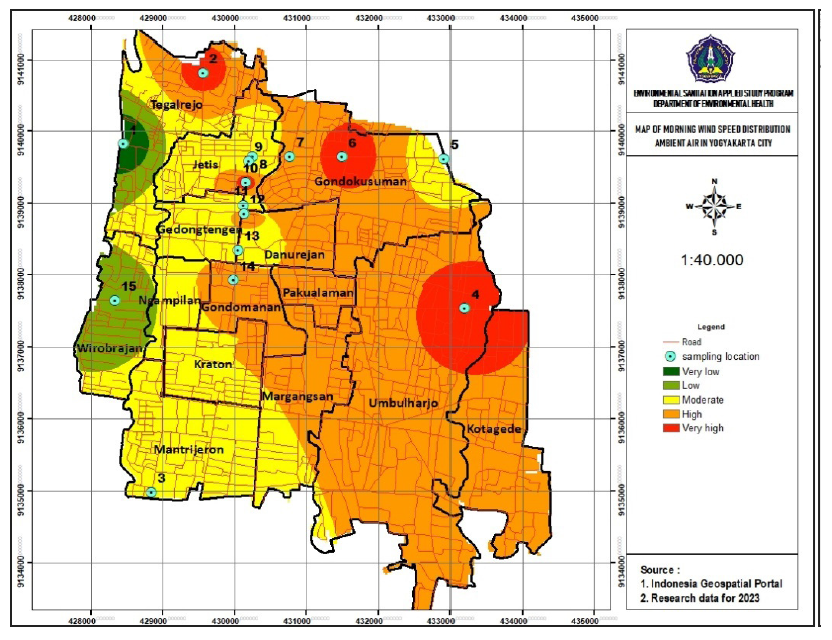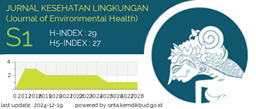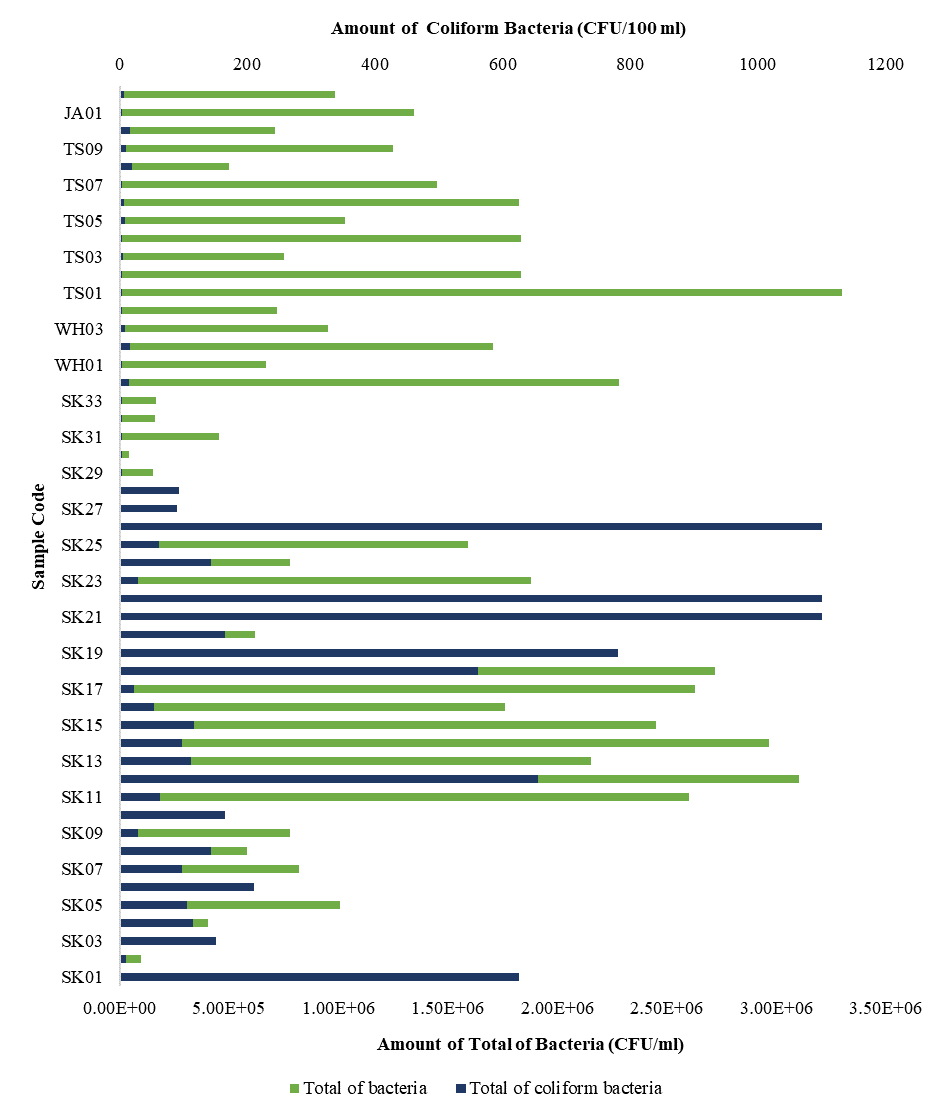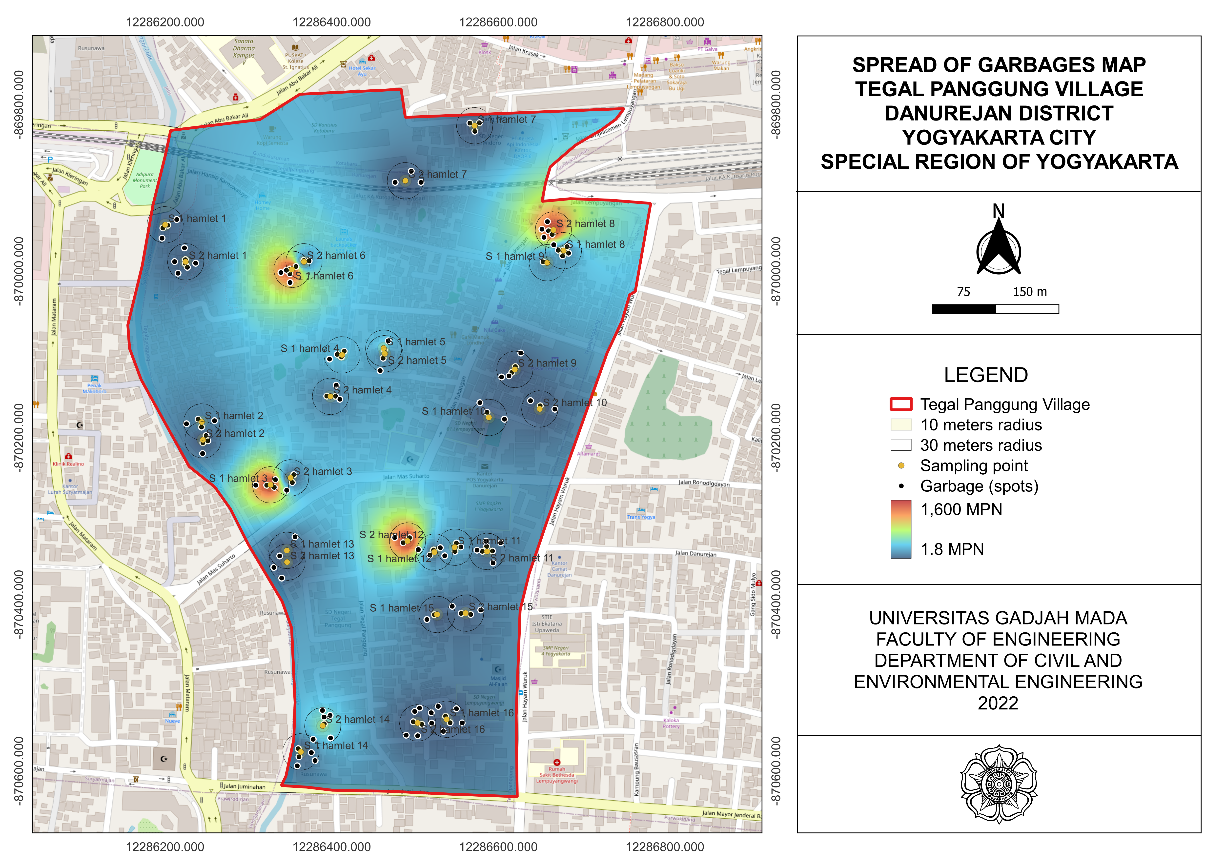Distribution of Motor Vehicle Volumes and Ambient Air Dust Levels in Hot Points of Yogyakarta City, Indonesia

Introduction: Yogyakarta City, Indonesia is a center for tourism, government, education, and the economy. In line with increasing mobility and transportation, this situation has a positive impact economically, but a negative impact in terms of air pollution due to vehicle emissions. Motorized vehicles contribute to air pollution reaching 66.34% of total pollution. PM2.5 is a critical parameter in the city of Yogyakarta. Methods: This research aims to determine the volume of motorized vehicle traffic and the distribution of dust levels in the ambient air of Yogyakarta City. Data collection used non-probability purposive sampling with the roadside method. Vehicle volume is mapped using hotspots and dust levels using interpolation. Results and Discussion: The average vehicle volume in the morning was 2,293.147 pcu/hour and in the afternoon it was 2,301.173 pcu/hour. The hotspot results showed that the volume of motorized vehicles in the morning category was very high at 2,921.600-5,655 pcu/hour and in the afternoon it was 3,678.800-4,558 pcu/hour. The average dust content in the morning is 0.10667 grams/m3 and in the afternoon it is 0.10240 grams/m3. The interpolation results showed that the distribution of dust levels in the very high category in the morning was 0.17000-0.20000 grams/m3 and in the afternoon it was 0.21000-0.26000 grams/m3. Conclusion: The highest average volume of vehicles occurs in the afternoon while the highest total dust content occurs in the morning.
Central Bureau of Statistics of Yogyakarta. Yogyakarta in Number 2022. Yogyakarta: Central Bureau of Statistics of Yogyakarta; 2022. https://yogyakarta.bps.go.id/publication/2022/02/25/05661ba4fe09161192c3fc42/provinsi-daerah-istimewa-yogyakarta-dalam-angka-2022.html
Central Bureau of Statistics of Yogyakarta. Yogyakarta in Number 2023. Yogyakarta: Central Bureau of Statistics of Yogyakarta; 2023. https://jogjakota.bps.go.id/publication/2023/02/28/9510c8b16be475ce64f99471/kota-yogyakarta-dalam-angka-2023.html
IQAir. World Air Quality Report by IQAir 2021. Jakarta: IQAir; 2021. https://www.iqair.com/id/newsroom/laporan-kualitas-udara-dunia-iqair-2021
Sembiring ETJ. Risiko Kesehatan Pajanan PM2,5 di Udara Ambien pada Pedagang Kaki Lima di Bawah Flyover Pasar Pagi Asemka Jakarta. J Tek Lingkung. 2020;26(1):101–120. https://doi.org/10.5614/j.tl.2020.26.1.7
Uniplaita J, Mangangka IR, Legrans RRI. Studi Penurunan Kualitas Udara Ambien Akibat Debu dari Kendaraan Bermotor (Studi Kasus: Jl. R. W. Monginsidi Depan Kawasan Bahu Mall Manado). Tekno. 2021;18(76):237–248. https://ejournal.unsrat.ac.id/index.php/tekno/article/view/31677
Sugiyono. Statistika untuk Penelitian. Bandung: Alfabeta; 2019.
Serlina Y. Pengaruh Faktor Meteorologi terhadap Konsentrasi NO2 di Udara Ambien (Studi Kasus Bundaran Hotel Indonesia DKI Jakarta). J Serambi Eng. 2020;5(3):1228–1235. https://ojs.serambimekkah.ac.id/index.php/jse/article/view/2146/1757
Utama YW, Permadi DA. Distribusi Temporal Konsentrasi PM10 Menggunakan Alat Particle Plus EM-10000. J Ecolab. 2021;15(1):45–52. http://dx.doi.org/10.20886/jklh.2021.15.1.45-52
Nugraha WS. Daftar Wisata di Sekitar Jalan Magelang di Yogyakarta. Yogyakarta: Tribun Jogja Wiki; 2020. https://tribunjogjawiki.tribunnews.com/2020/04/07/daftar-wisata-di-sekitar-jalan-magelang-di-yogyakarta
Karim MS, Handayani AT, Astutik HP. Kinerja Ruas Jalan Saat Kondisi New Normal (Studi Kasus Jalan Laksda Adisutjipto, Yogyakarta KM 6,3-6,8). Equilib. 2021;2(1):13–20. https://journal.itny.ac.id/index.php/equilib/article/view/2127
Hidayat AW. Pengaruh Hambatan Samping Terhadap Kinerja Jalan (Studi Kasus Ruas Jalan Depan Pasar Mayong Jepara). INERSIA lnformasi dan Ekspose Has Ris Tek Sipil dan Arsit. 2020;16(2):171–178. https://doi.org/10.21831/inersia.v16i2.36902
Oktavila, Sulistyorini D, Sutrisno W. Evaluasi Kinerja Ruas Jalan Laksda Adisucipto KM 4,4 Yogyakarta Menggunakan Metode PKJI 2014. Skripsi. Yogyakarta: Universitas Sarjanawiyata Tamansiswa; 2022.
Hasanudin U. Lalu Lintas Jogja: Jalan Jenderal Sudirman Diusulkan Dua Arah. Yogyakarta: Harian Jogja; 2014. https://jogjapolitan.harianjogja.com/read/2014/10/13/510/543853/lalu-lintas-jogja-jalan-jenderal-sudirman-diusulkan-dua-arah
Fitriyah F, Indriyani YS, Sumiardi A. Pengaruh Kendaraan Bermotor Terhadap Pencemaran Udara di Kecamatan Ciruas Serang Banten. J Sustain Civ Eng. 2022;04(02):89–98. https://doi.org/10.47080/josce.v4i02.2206
Ma'rufi I. Analisis Risiko Kesehatan Lingkungan (SO2, H2S, NO2 dan TSP) Akibat Transportasi Kendaraan Bermotor di Kota Surabaya. MPI (Media Pharm Indones). 2018;1(4):189–196. https://doi.org/10.24123/mpi.v1i4.770
Gunawan H, Ruslinda Y,Bachtiar SV, Dwinta A. Model Hubungan Konsentrasi Particulate Matter 10 PM (PM10) di Udara Ambien dengan Karakteristik Lalu Lintas di Jaringan Jalan Primer Kota Padang. Semin Nas Sains dan Teknol. 2018;17(15):1–11. https://jurnal.umj.ac.id/index.php/semnastek/article/view/3557
Nuraini TA, Permana DS, Satyaningsih R, Anggraeni R, Aldrian E. Comparison of Total Suspended Particulate (TSP) Measurement in Urban and Suburban Areas of Bali during Nyepi Day 2015. Forum Geogr. 2020;33(2):173–183. https://doi.org/10.23917/forgeo.v33i2.8670
Zhao Y, Zhao C. Concentration and Distribution Analysis of Heavy Metals in Total Suspended Particulates along Shanghai-Nanjing Expressway. Procedia Environ Sci. 2012;13(2011):1405–1411. http://dx.doi.org/10.1016/j.proenv.2012.01.133
Hadi BS. Pemantauan Kualitas Udara Ambien Pm10 dan Risiko Kesehatan Terhadap Masyarakat di Kabupaten Sleman, Daerah Istimewa Yogyakarta. Skripsi. Yogyakarta: Universitas Islam Indonesia 2021.
Ihsan IM, Yani M, Hidayat R, Permatasari T. Fluktuasi Cemaran Udara Partikulat dan Tingkat Risikonya terhadap Kesehatan Masyarakat Kota Bogor. J Teknol Lingkung. 2021;22(1):38–47. https://doi.org/10.29122/jtl.v22i1.4439
Fatimah CL, Darundiati YH, Joko T. Hubungan Kadar Debu Total dan Masa Kerja dengan Gangguan Fungsi Paru pada Pedagang Kaki Lima di Jalan Brigjen Sudiarto Kota Semarang. J Kesehat Masy. 2018;6(6):49–60. https://ejournal3.undip.ac.id/index.php/jkm/article/view/22156
Chowdhury AI, Uddin MJ, Baul TK, Akhter J, Nandi R, Karmakar S, et al. Quantifying the Potential Contribution of Urban Trees to Particulate Matters Removal: A study in Chattogram City, Bangladesh. J Clean Prod. 2022;380(135015):1-8. https://doi.org/10.1016/j.jclepro.2022.135015
Oktaviani E. Paparan Particulate Matter (PM10) dan Total Suspended Particulate (TSP) di Trotoar Beberapa Jalan Kota Surabaya. Thesis. Surabaya: Institut Teknologi Sepuluh November; 2018.
Safaat AIFW, Aly SH, Harusi NMR. Analisis Polutan Total Suspended Particulate (TSP) Pada Jalan Arteri Divided di Kota Makassar. Univ Indones. 2021;9(2):43–54. https://ppjp.ulm.ac.id/journal/index.php/jukung/article/download/17571/9473
Sari YW, Darnas Y, Hamdan AM. Karakterisasi Sifat Magnetik Daun untuk Analisa Polusi Udara: Sebuah Tinjauan Ulang. J Serambi Eng. 2020;5(4):1367–1377. https://doi.org/10.32672/jse.v5i4.2324
Utomo HP, Ratnawati R. Evektivitas Vegetasi untuk Penurunan Kadar Karbon monoksida (CO) dan Nitrogen Dioksida (CO2). J Tek Waktu. 2021;19(2):38–43. https://doi.org/10.36456/waktu.v19i01.3638
Park S, Cai Y, Lim H, Song D. Analysis of Vertical Movement of Particulate Matter due to The Stack Effect in High-Rise Buildings. Atmos Environ. 2022;279(1):119113. https://doi.org/10.1016/J.ATMOSENV.2022.119113
Wibowo NA, Hadiwono A. Air-Chitecture: Sebuah Desain Bangunan dengan Purifikasi Udara Secara Teknis dan Puitis Dalam Konteks Berhuni. J Sains Teknol Urban Perancangan Arsit. 2021;3(1):589-600. https://doi.org/10.24912/stupa.v3i1.10748
Yáñez MA, Baettig R, Cornejo J, Zamudio F, Guajardo J, Fica R. Urban Airborne Matter in Central and Southern Chile: Effects of Meteorological Conditions on Fine and Coarse Particulate Matter. Atmos Environ. 2017;161(1):221–234. https://doi.org/10.1016/j.atmosenv.2017.05.007
Sulistiani I, Partama IGY, Surata SPK, Sumantra IK. Dinamika Kualitas Udara Ambien Selama Masa Pandemi Covid-19 di Kawasan Indonesia Tourism Development Corporation Nusa Dua Bali. ECOTROPHIC: J Ilmu Lingkung. 2021;15(1):124-137. https://doi.org/10.24843/ejes.2021.v15.i01.p11
Ibrahim Z, Boekoesoe L, Lalu NAS. Identifikasi Kualitas Udara Ambien Disekitar Wilayah Kota Gorontalo. Public Heal Surveilance Rev. 2022;1(1):24–33. https://ejurnal.ung.ac.id/index.php/phsr/article/view/16414
Fauziah DA, Rahardjo M, Astorina N, Dewanti Y. Analisis Tingkat Pencemaran Udara di Terminal Kota Semarang. J Kesehat Masy. 2017;5(5):561–570. http://ejournal3.undip.ac.id/index.php/jkm

This work is licensed under a Creative Commons Attribution-NonCommercial-ShareAlike 4.0 International License.
1. Copyright of all journal manuscripts is held by the Jurnal Kesehatan Lingkungan.2. Formal legal provisions to access digital articles of electronic journal are subject to the provision of the Creative Commons Attribution-ShareAlike license (CC BY-NC-SA), which means that Jurnal Kesehatan Lingkungan is rightful to keep, transfer media/format, manage in the form of databases, maintain, and publish articles.
3. Published manuscripts both printed and electronic are open access for educational, research, and library purposes. Additionally, the editorial board is not responsible for any violations of copyright law.
JKESLING by UNAIR is licensed under a Creative Commons Attribution-ShareAlike 4.0 International License.







































